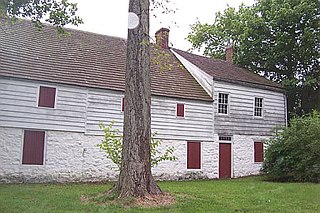 W
WHistoric Richmond Town is an authentic town and farm museum complex in the neighborhood of Richmondtown, Staten Island, in New York City. It is located near the geographical center of the island, at the junction of Richmond Road and Arthur Kill Road. Staten Island Historical Society and Historic Richmond Town are two different names for the same organization, reflecting its long history and evolution.
 W
WThe Lake–Tysen House is a spacious farmhouse with Dutch and Flemish architectural details. It was built by Joseph Guyon on his farmstead in Oakwood, Staten Island in the United States. Most of its original interior woodwork, including both Georgian and Federal styles of paneling remains intact. Based on the style and proportions of the house, it would be considered a middle-to-upper-class dwelling. The Lake family owned several slaves, who may have been housed in the rooms above the kitchen. The building was acquired by Historic Richmond Town, a living history museum, in 1962, and transported from Oakwood during July 9–12, 1962. The building was restored before it was opened to the public on October, 1963. Full restoration was completed in the 1970s.
 W
WThe Boehm House is an historic house at 75 Arthur Kill Road in the Richmondtown section of the borough of Staten Island in New York City. This 1750 house, relocated from Greenridge as a part of Historic Richmondtown, was typical of rural New York during the American Revolution. Also on view in the house: an exhibit of early building techniques and restorations. It was designated a New York City landmark in 1969 as the "Boehm-Frost House".
 W
WThe Britton Cottage, formerly known as the Cubberly House, is a house in the Historic Richmond Town museum complex in the neighborhood of Richmondtown, Staten Island, in New York City. The oldest section of the cottage dates to 1671, with additions in the mid-18th century. It is constructed of stone and timberframe components. The house was originally located at the intersection of New Dorp Lane and Cedar Grove Avenue in the New Dorp Beach section of Staten Island, but was moved to its current location in 1967 when it was threatened with demolition.
 W
WThe Christopher House is a stone masonry farmhouse at Historic Richmond Town in Staten Island, New York City. It is associated with two of the oldest Staten Island families. It was also used as a meeting place during the American Revolution, while being the residence of Joseph Christopher, a member of the Richmond County Committee of Safety from 1775-1776. It was moved to Historic Richmond Town in late 1969 and restored for museum presentation from 1975-1977.
 W
WThe Stephens-Black House is a 19th-century house featured in Historic Richmond Town on Staten Island, New York City. It was designated as a New York City Landmark on August 26, 1969.
 W
WThe Third County Courthouse is an 1837 Greek Revival building at 302 Center Street in Historic Richmond Town, near the geographic center of Staten Island, New York. Preceded by two smaller courthouses, it was the Richmond County Courthouse during most of the nineteenth century and was in use until 1919, when it was replaced by the Richmond County Courthouse in St. George.
 W
WThe Treasure House is a historic building located in Staten Island, New York City, New York, US. Samuel Grasset, a tanner and leather worker, built the original construction in approximately 1700. Additions were made in 1740, 1790 and 1860. Subsequent owners of the house in subsequent centuries include a cord wainer (shoemaker), innkeeper, stonemason, and coach trimmer. A number of local businesses have also occupied the structure. The house was named after a legend that a cache of American Revolutionary War era gold coins was discovered during renovation in about 1860.
 W
WThe Voorlezer's House is a historic clapboard frame house in Historic Richmond Town in Staten Island, New York. It is widely believed to be the oldest known schoolhouse in America, although the sole inhabitant to hold the title of voorlezer, Hendrick Kroesen, only lived on the property from 1696 until 1701. The present structure became a private residence for more than a century and is now owned and operated by the Staten Island Historical Society. Despite being traditionally dated to before 1696 and sitting on land patented in 1680, it is more likely to have been constructed in the mid-eighteenth century, probably in the 1760s by Jacob Rezeau, whose family came into possession of the property in 1705.